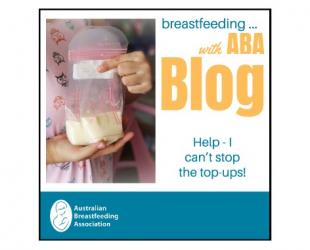Many mums are told to give their baby top-up feeds.
What happens when you do this and is there another way?

Most mums can produce enough breastmilk
Pregnancy prepares your breasts for making milk. In the the early days after birth, high hormone levels drive the amount of breastmilk you make. When your baby drinks the milk stored in your breasts, they make more milk to replace it. After those early hormones settle down, the amount of milk you make becomes controlled by the amount of milk that is removed from your breasts.
Your body makes milk all the time, so your breasts are never “empty”. If the milk is not removed, this process slows down and after a while your breasts make less milk.
If you do have a low supply, it is often because your baby isn’t taking enough milk, rather than you not being able to make enough milk. Usually, feeding more often and improving your baby’s attachment will increase your supply.
Feeding from a bottle
When you give your baby a bottle, you may be surprised at the large amount they seem to drink. Many mums think this means baby is hungry and they aren't making enough milk. This reinforces the idea that they need to give top-ups.
There are reasons why many babies seem to take a lot from a bottle:
- A baby’s sucking instinct is so strong that even if they've had enough milk from the breast, they may still drink more from a bottle.
- Babies usually drink a bottle quickly because they are trying to cope with the flow, not because they are hungry.
- Taking milk from a bottle is easier because a baby doesn’t have to ‘milk’ the teat in the same way as the breast.
You can't judge your breastmilk supply by how much your baby takes from a top-up feed.
If you give extra formula on a regular basis, this will reduce your supply.
Do I need to top up?
Check your milk supply first
- There are lots of reasons mums may think they have a low supply.
Signs your baby is getting enough milk
- At least 5 heavily wet disposable nappies or at least 6 pale very wet cloth nappies in 24 hours
- Poos are soft
- Good skin tone and bright eyes
- Generally content, even if sometimes fussy and unsettled
- Gaining weight, growing in length and head circumference
If your baby shows these signs, then your supply is fine, even if:
- The early feeling of fullness passes
- Your breasts are softer
- Your baby feeds more frequently
- Your baby's feeds become shorter
- Your baby is older and you stop feeling a let-down
- Your baby has a few fussy or 'hungry' days
- Your older baby begins to poo less often
- Your baby's weight gain slows from large gains in the early weeks OR your large baby's weight gain slows temporarily.
How can I top up and protect my supply?
First take steps to increase your supply:
-
Increase the number of feeds in 24 hours
-
Increase the number of 'sides' at each feed, for example offer each side twice
-
Use breast compressions during feeds to help your milk flow
If your baby needs a top-up:
-
Express between feeds so you can top baby up with your own milk
-
Give any top-up feeds from a syringe, small cup, paced bottle feeding or with a supply line at the breast
-
Offer only small top-ups, just enough to keep baby satisfied for a short time so they are hungry for their next breastfeed.
Most mums can successfully increase their supply with the right information, helpful suggestions and support.
You may like to speak with an ABA breastfeeding counsellor to make a plan for building your supply and decreasing the top-ups.
© Australian Breastfeeding Association January 2023


